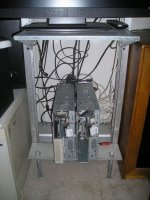Therein lies the rub. I'm not an admin of any type, by any stretch of the imagination . . .
. . . unless SneakerNet counts? :lol:
Would giving each MicroQuadra its own dedicated SCA drive help at all?
I'll look into the Quadra 630/Performa 6xx angle, that'd be really easy. I wouldn't even bother trying to make a backplane, just remove all the plastics and bolt 'em up with standoffs . . .
. . .
ooooh!!!!! :O
< scampers off to play with hardware >

I can mount 'em vertically in bricks of four on the TelCo rack. Two bricks will fit under the 32" HDTV with room left over for a KM drawer.
Unfortunately the Two SIMM Slotted 640 DOS variant is in demand, those would rock, but I only have the one Q630 MoBo ATM. :-/
CS1 NICs will be difficult to source as well I think.
I've already got The OmniView Mac converter and MiniView four port PS/2 KVM, the cables for which
can easily be converted to ADB. Would a
"KVM'd" serial port connection be of any use?
-- Chassis would be a galvanized sheet metal enclosure behind the uprights for added cubic
-- largest cooling fan available to boost airflow on back of chassis
-- weatherstrip guide the exhaust fans, directing airflow toward auxiliary fan on backplane
-- MiniView four port PS/2 KVM with converted input connectors
-- Power Strip
Advantages:
-- retains Class A RFI shielding
-- retains UL approved packaging
-- available FDDs for boot
-- IDE a/o CD bay SCA converter options
I've got the MiniView A/B switch to gang two bricks of four Nodes each already hooked up to the Mac Converter . . .
. . . with four more 4 Port Miniview KVMs I can handle 4 Bricks/Sixteen nodes . . .
. . . and a Foundry Networks 24 port thingamajig If I decide to fill the Rack . . .
. . . to run it as a space heater for the winter months. :lol:


